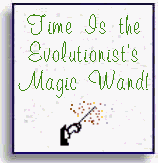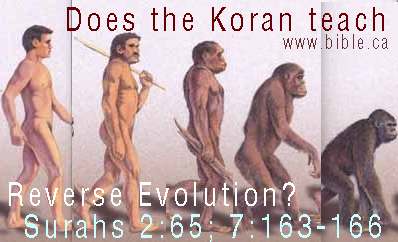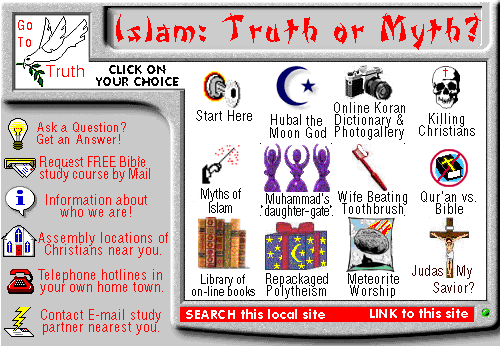Some of the pre-Islamic Sources for material in the Quran
The Quran repeats fanciful Arabian fables as if they were true.
"Arabic legends about the fabulous jinns fill its pages" (G.G. Pfander, Balance of Truth, pp. 283).
"The story of the she-camel who leapt out of a rock and became a prophet was known long before Muhammad" (Suras 7:73-77,85; 91:14; 54:29).
The story of an entire village of people who were turned into apes because they broke the sabbath by fishing was a popular legend in Muhammad's day (Suras 2:65; 7:163-166).
The gushing 12 springs story found in Sura 2:60 comes from pre-Islamic legends.
In what is called the "Rip Van Winkle" story, seven men and their animals slept for 309 years in a cave and then woke up perfectly fine (Sura 18:9-26)!
This legend is found in Greek and Christian fables as well as Arabian lore.
The fable of the pieces of four dead, cut-up birds getting up and flying was well known in Muhammad's time (Sura 2:260).
It is also clear that Muhammad used such pre-Islamic literature as the Saba Moallaqat of Imra'ul Cays in his composition of Suras 21:96; 29:31,46; 37:59; 54:1, and 93:1.
Many of the stories in the Quran come from the Jewish Talmud, the Midrash, and many apocryphal works.
This was pointed out by Abraham Geiger in 1833, and further documented by another Jewish scholar, Dr. Abraham Katsh, of New York University, in 1954 (The Concise Dictionary of Islam, p. 229; Jomier, The Bible and the Quran -- Henry Regency Co., Chicago, 1959, 59ff; Sell, Studies, pp. 163ff.; Guillaume, Islam, p. 13).
1. The source of Sura 3:35-37 is the fanciful book called The Protevangelion's James the Lesser.
2. The source of Sura 87:19 is the Testament of Abraham.
3. The source of Sura 27:17-44 is the Second Targum of Esther.
4. The fantastic tale that God made a man "die for a hundred years" with no ill effects on his food, drink, or donkey was a Jewish fable (Sura 2:259ff.).
5. The idea that Moses was resurrected and other material came from the Jewish Talmud (Sura 2:55, 56, 67).
6. The story in Sura 5:30,31 can also be found in pre-Islamic works from Pirke Rabbi Eleazer, the Targum of Jonathan ben Uzziah and the Targum of Jerusalem.
7. The tale of Abraham being delivered from Nimrod's fire came from the Midrash Rabbah (see Suras 21:51-71; 29:16, 17; 37:97,98).
It must be also pointed out that Nimrod and Abraham did not live at the same time. Muhammad was always mixing people together in the Quran who did not live at the same time.
8. The non-biblical details of the visit of the Queen of Sheba (Saba) in Sura 27:20-44 came from the Second Targum of the Book of Esther.
9. The source of Sura 2:102 is no doubt the Midrash Yalkut (chapter 44).
10. The story found in Sura 7:171 of God lifting up Mount Sinai and holding it over the heads of the Jews as a threat to squash them if they rejected the law came from the Jewish book Abodah Sarah.
11. The story of the making of the golden calf in the wilderness, in which the image jumped out of the fire fully formed and actually mooed (Suras 7:148; 20:88), came from Pirke Rabbi Eleazer.
12, The seven heavens and hells described in the Quran came from the Zohar and the Hagigah.
13. Muhammad utilized the Testament of Abraham to teach that a scale or balance will be used on the day of judgment to weigh good and bad deeds in order to determine whether one goes to heaven or hell (Suras 42:17; 101:6-9).
One of the most documented and damaging facts about the Quran is that Muhammad used heretical "Christian" Gnostic gospels and their fables for material in the Quran.
Encyclopedia Britannica comments:
"The gospel was known to him chiefly through apocryphal and heretical sources" (15:648).
This has been demonstrated many times by various scholars (Richard Bell, Introduction to the Quran, pp. 163ff. See also: Bell, The Origin of Islam in Its Christian Environment, pp. 110ff, 139ff; Sell, Studies, pp. 216ff. See also Tisdall and Pfander).
For example, in Suras 3:49 and 100:11O, the baby Jesus speaks from the cradle! Later on, the Quran has Jesus making clay birds come alive.
The Bible tells us that the first miracle Jesus did was at the wedding at Cana (John 2:11).
Muhammad incorporated parts of the religion of the Sabeans into Islam (Encyclopedia off Islam (ed. Eliade), pp. 303ff.; International Standard Bible Encyclopedia, pp. 1:219ff.).
He adopted such pagan rituals as:
Worshiping at Kabah
Praying five times a day towards Mecca (Muhammad chose five of the same times the Sabeans prayed).
Fasting for part of a day for an entire month.
Muhammad derived some of his ideas from Eastern religions such as Zoroastrianism and Hinduism. All of these things were in existence long before Muhammad was born.
The Quran records the following things which are ascribed to Muhammad but in reality were previously known stories now attributed to him for the first time (Sell, Studies, pp. 219ff.).
The story of a flying trip through seven heavens.
The Houries of paradise.
Azazil and other spirits coming up from Hades.
The "light" of Muhammad.
The bridge of Sirat.
Paradise with its wine, women, and song (from the Persians).
The king of death.
The peacock story.
According to the literal Arabic translation of Sura 3:106, 107, on Judgment Day, only people with white faces will be saved. People with black faces will be damned.
|



